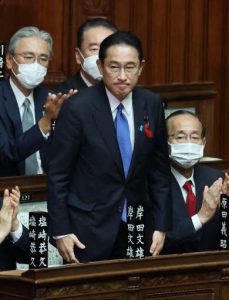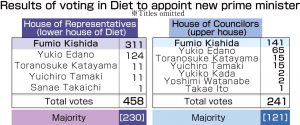Kishida is elected from A-bombed Hiroshima as Japan’s 100th prime minister: New Cabinet launches with 13 first-time members and top priority on coronavirus
Oct. 5, 2021
by Seiji Shitakubo, Staff Writer
On October 4, Fumio Kishida, 64, president of the Liberal Democratic Party (LDP) and a member of the House of Representatives (lower house of the Diet) representing Hiroshima’s District No. 1, was elected as Japan’s 100th prime minister, following a vote to appoint the prime minister in a Joint Plenary Meeting of Party Members of both houses of the Diet. Mr. Kishida is the second prime minister from Hiroshima City since Tomosaburo Kato, who served in the office before World War II, and the first since the atomic bombing. Following a prime minister swearing-in ceremony and Cabinet minister attestation ceremony held at the Imperial Palace in Tokyo the same night, the new Kishida Cabinet, consisting of members from both the Liberal Democratic Party (LDP) and the Komeito party, got its start. The new government headed by Mr. Kishida will inherit difficult challenges, including the coronavirus pandemic and economic recovery, from Yoshihide Suga, 72, the former prime minister who stepped down after slightly more than one year in office.
At a press conference at the prime minister’s official residence, Mr. Kishida reiterated his policies related to efforts for handling the coronavirus as a top priority, along with the development of economic recovery measures worth several ten trillion yen. With the goal of establishing a new kind of capitalism, he expressed his ideas for mitigating economic disparity through a virtuous cycle of growth and distribution and declared his aim to create a joint Cabinet for the new era incorporating the views of the Japanese public.
Mr. Kishida signaled his wariness about signing and ratifying the Treaty on the Prohibition of Nuclear Weapons (TPNW), which entered into force this past January. But, he said, “U.S. President Joe Biden announced globally he would seek a world without nuclear weapons. I want to communicate with him and consider what we can do to help achieve that major goal.”
In total, 458 votes were cast in Japan’s House of Representatives for appointment of the new prime minister.
This election of the fourth prime minister from among lawmakers based in Hiroshima Prefecture was the first in 30 years, since Kiichi Miyazawa assumed the post in 1991. Mr. Kato, who took office in 1922 (during Japan’s Taisho era), was Hiroshima Prefecture’s first prime minister. In 1960, Hayato Ikeda was the next to be elected prime minister from the prefecture.
All members of the previous Suga Cabinet resigned at an extraordinary Cabinet meeting held in the morning on October 4. Mr. Suga served in the post of prime minister for 384 days, the 12th shortest period among the terms of the 34 prime ministers to have served in the office since the end of the war in 1945.
Profile
Fumio Kishida: Graduated from Waseda University. After working at the Long-Term Credit Bank of Japan and serving as secretary for a member of the House of Representatives (the Diet’s lower house), he was elected to the House of Representatives for the first time in 1993. He has held such positions as LDP’s Youth Division Director, Minister of State for Okinawa and Northern Territories Affairs, Chairperson of the LDP Diet Affairs Committee, Ministry of Foreign Affairs, and Chairperson of the LDP Policy Research Council. He is 64 years old. He was elected to the House of Representatives nine times in total, representing Hiroshima’s District No. 1 (Kishida Faction).
(Originally published on October 5, 2021)
On October 4, Fumio Kishida, 64, president of the Liberal Democratic Party (LDP) and a member of the House of Representatives (lower house of the Diet) representing Hiroshima’s District No. 1, was elected as Japan’s 100th prime minister, following a vote to appoint the prime minister in a Joint Plenary Meeting of Party Members of both houses of the Diet. Mr. Kishida is the second prime minister from Hiroshima City since Tomosaburo Kato, who served in the office before World War II, and the first since the atomic bombing. Following a prime minister swearing-in ceremony and Cabinet minister attestation ceremony held at the Imperial Palace in Tokyo the same night, the new Kishida Cabinet, consisting of members from both the Liberal Democratic Party (LDP) and the Komeito party, got its start. The new government headed by Mr. Kishida will inherit difficult challenges, including the coronavirus pandemic and economic recovery, from Yoshihide Suga, 72, the former prime minister who stepped down after slightly more than one year in office.
At a press conference at the prime minister’s official residence, Mr. Kishida reiterated his policies related to efforts for handling the coronavirus as a top priority, along with the development of economic recovery measures worth several ten trillion yen. With the goal of establishing a new kind of capitalism, he expressed his ideas for mitigating economic disparity through a virtuous cycle of growth and distribution and declared his aim to create a joint Cabinet for the new era incorporating the views of the Japanese public.
Mr. Kishida signaled his wariness about signing and ratifying the Treaty on the Prohibition of Nuclear Weapons (TPNW), which entered into force this past January. But, he said, “U.S. President Joe Biden announced globally he would seek a world without nuclear weapons. I want to communicate with him and consider what we can do to help achieve that major goal.”
In total, 458 votes were cast in Japan’s House of Representatives for appointment of the new prime minister.
This election of the fourth prime minister from among lawmakers based in Hiroshima Prefecture was the first in 30 years, since Kiichi Miyazawa assumed the post in 1991. Mr. Kato, who took office in 1922 (during Japan’s Taisho era), was Hiroshima Prefecture’s first prime minister. In 1960, Hayato Ikeda was the next to be elected prime minister from the prefecture.
All members of the previous Suga Cabinet resigned at an extraordinary Cabinet meeting held in the morning on October 4. Mr. Suga served in the post of prime minister for 384 days, the 12th shortest period among the terms of the 34 prime ministers to have served in the office since the end of the war in 1945.
Profile
Fumio Kishida: Graduated from Waseda University. After working at the Long-Term Credit Bank of Japan and serving as secretary for a member of the House of Representatives (the Diet’s lower house), he was elected to the House of Representatives for the first time in 1993. He has held such positions as LDP’s Youth Division Director, Minister of State for Okinawa and Northern Territories Affairs, Chairperson of the LDP Diet Affairs Committee, Ministry of Foreign Affairs, and Chairperson of the LDP Policy Research Council. He is 64 years old. He was elected to the House of Representatives nine times in total, representing Hiroshima’s District No. 1 (Kishida Faction).
(Originally published on October 5, 2021)









